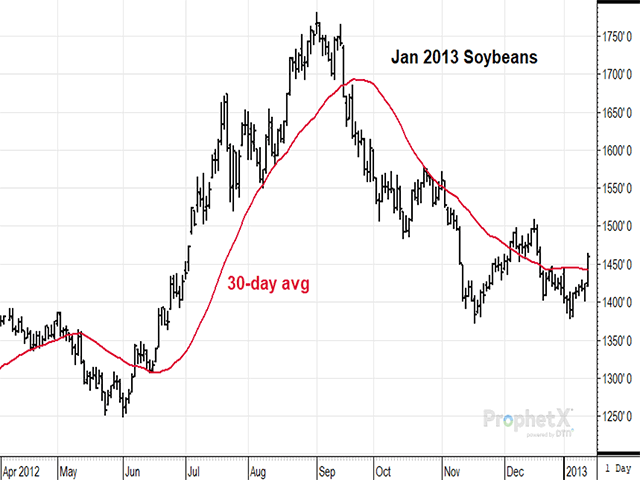Todd's Take
Dynamics of a Soybean Bull Market
As recently as early August, the U.S. soybean crop was sporting a 74% good-to-excellent crop rating, the highest in at least 10 years. USDA was estimating U.S. ending stocks at a comfortable 610 million bushels (mb) -- a surplus that pointed to a cash price target of $8.50 a bushel, based on historical trades.
Frankly, many of us were relieved at the time to see China become more active, making soybean purchases, as the unexpected demand kept soybean prices above their April lows made during the emotional heights of the first coronavirus scare.
At the time, considering coronavirus concerns plus the possibility of a record soybean crop made it seem likely prices would come under pressure at harvest time. But, as we now know, that did not happen. Instead, January soybeans closed at $11.77 1/2 a bushel Thursday, over $3 above the August low and the highest spot close in four years.
Because of rising soybean prices in Brazil, we did know China was aggressively buying Brazilian soybeans in late July, but nobody had a clue China would now be holding sales slips for 1.05 billion bushels (bb) of U.S. soybeans and possibly more when unknown destinations are revealed.
It is unfortunate the U.S. does not have the same transparent access to China's grain supply information that the U.S. freely provides the rest of the world. Without that, the U.S. has no good warning system of impending food shortages and U.S. soybean prices are now at risk of spiraling higher.
How high might soybeans go? According to USDA's November WASDE estimate, producers can expect an average farm price of $10.40 a bushel in 2020-21. I personally think that's too low, but of course an average price does not offer a prediction for the ultimate peak. Given the current factors at play, the peak could be much higher than most currently expect.
I don't say that because I have a crystal ball, but because I know markets are people and people are emotional. When people get emotional, you can toss out the academic calculations -- this market has the makings of a free-for-all.
P[L1] D[0x0] M[300x250] OOP[F] ADUNIT[] T[]
Here is how this kind of situation often works. The market has been surprised to find out available soybean supplies are much lower than expected and, in fact, are in danger of running out.
Those who still own soybeans step back from the market, hanging on to see how high prices might go. This has the effect of tightening available soybean supplies even further.
Noncommercials (speculators) get excited by soybeans' rising prices -- as they did in late August -- and add further to net-long positions, bidding prices even higher. Speculators that were short the market find themselves on the losing end and are forced to buy back their positions to stop the bleeding. Some will turn and go long.
End users that need soybeans may respond in a variety of ways, but increasingly find it difficult to protect future purchase prices in a rapidly rising market. At some point, they will try to find ways to stop buying, if they can find a reasonable substitute. Soybean meal has a lot of feed benefits that aren't easily replaced.
Until some event or change of attitude comes along, the spiral of speculative buying continues to bid prices higher in search of willing sellers that become increasingly difficult to find. Where that last burst of buying happens is anyone's guess, but then watch out. A bullish market exhausted of buyers is a dangerous sight to behold, and the price collapse that ensues can be just as sharp going down as it was going up.
In 1641, Scottish author Charles Mackay described how people from all walks of life gave up houses and lands at ruinous prices to invest in rising tulip prices that were making people instantly rich ("Extraordinary Popular Delusions and the Madness of Crowds"). People aren't much different these days, and that kind of seduction is difficult to resist.
I wish I had that crystal ball to tell us where this soybean price will end, but I can't say I've found it yet. I do know enough to say the top will not be found in a mathematical calculation based on past prices and ending supplies -- it's much more complicated than that.
Soybean producers need to know, as bullish as the current situation is, the clock can strike midnight before anyone suspects. What you don't want to do is get caught up in trying to outguess the market's manic-behavior -- that's a dangerous game most will lose.
My advice for those who own soybeans? As I've already said earlier when prices were lower than they now are, sell at least 75% of 2020 production while the prices are still good.
For the remaining 25% of production, pick your best price or pay attention to DTN's Soybean Market Strategies where customers will receive notification of DTN's final soybean sale for 2020-21.
Best wishes in a market that could soon get volatile.
**
DTN market analysts make general market comments for educational purposes, but do not make specific recommendations for particular farm situations. The buying and selling of commodities and futures contracts involve substantial risk and are not suitable for everyone.
Todd Hultman can be reached at Todd.Hultman@dtn.com
Follow him on Twitter @ToddHultman1
(c) Copyright 2020 DTN, LLC. All rights reserved.




